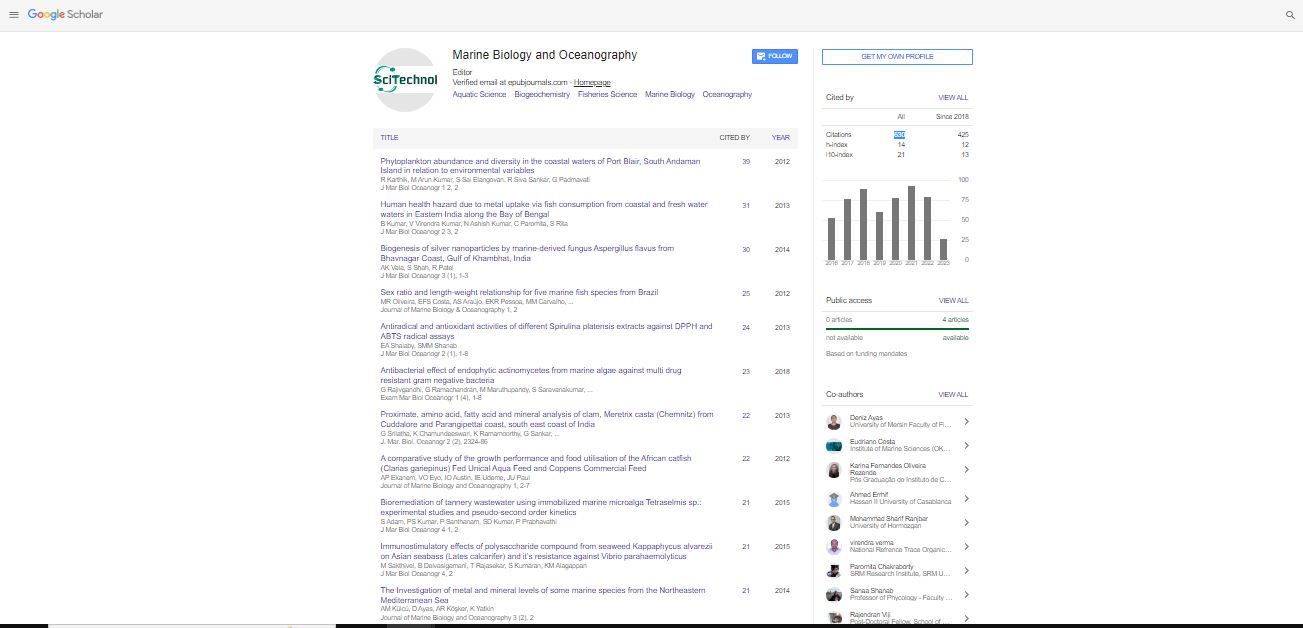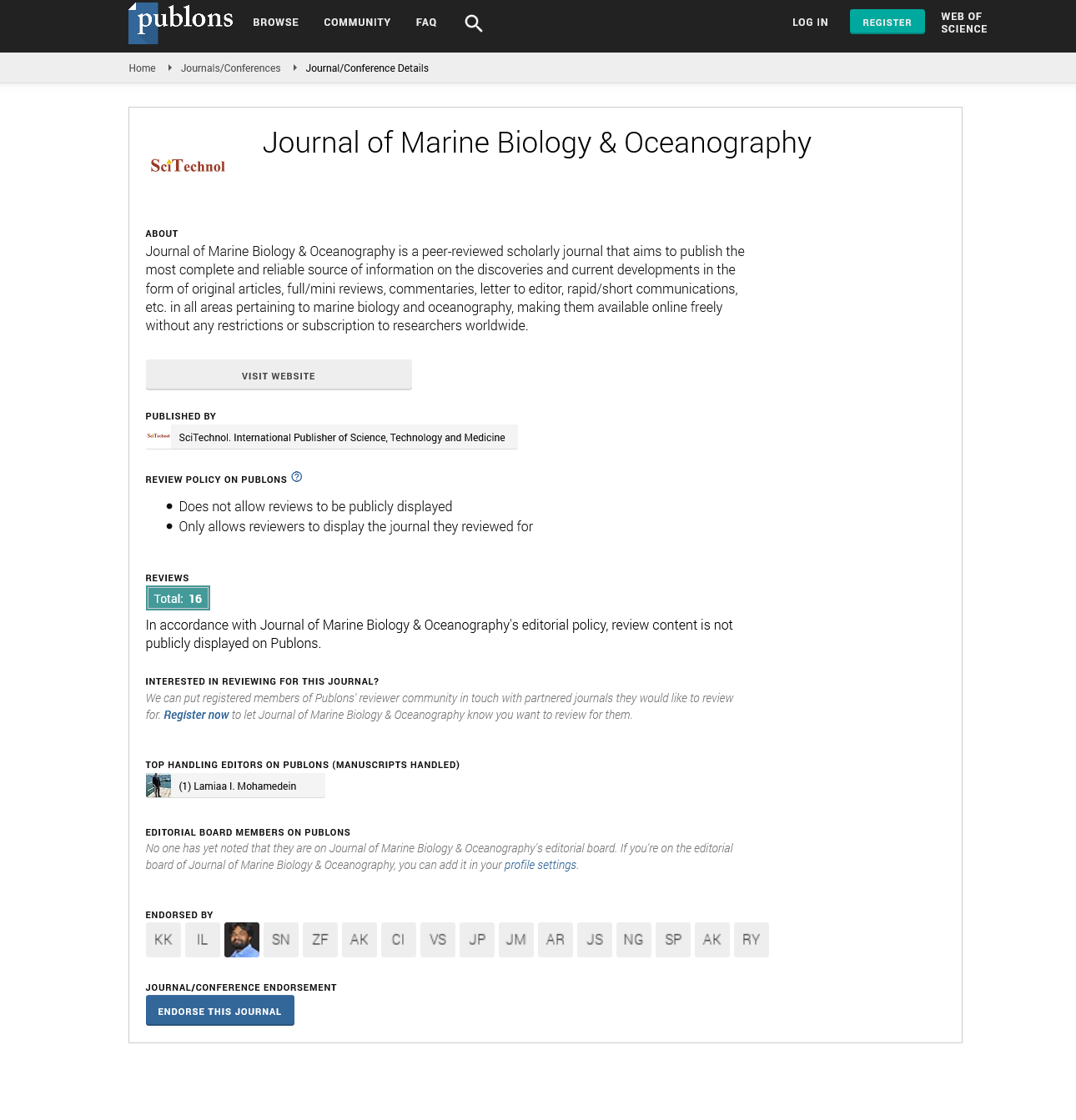Commentary, J Mar Biol Oceanogr Vol: 11 Issue: 5
Advances in Chemistry and Bioactivity of Marine Cyanobacteria
Margret Jones*
Department of Biochemistry, Pantheon-Sorbonne University, Paris, France
*Corresponding author: Margret Jones
Department of Biochemistry, Pantheon-Sorbonne University, Paris, France
Email: jones_m567@edu.fr.com
Received date: 18 April, 2022; Manuscript No. JMBO-22-52524;
Editor assigned date: 20 April, 2022; PreQC No. JMBO-22-52524 (PQ);
Reviewed date: 29 April, 2022; QC No. JMBO-22-52524;
Revised date: 09 May, 2022; Manuscript No. JMBO-22-52524 (R);
Published date: 19 May, 2022; DOI: 10.4172/2324-8661.1000244
Citation: Vitalis L (2022) Advances in Chemistry and Bioactivity of Marine Cyanobacteria. J Mar Biol Oceanogr 11:5.
Keywords: Marine Chemistry
Description
Three-dimensional scanning and printing technologies has proved to be a boon and revolutionized Indian society in recent times. 3D printing is sluggishly gaining fashion ability in the fields of forensics due to its capability to give information in all three axis and z) when compared to 2D photographs. The technology is laboriously being used in the fields of forensic drug, anthropology, ballistics and odontology. 3D printing allows better visualization, interpretation, preservation and analysis of the substantiation. The present composition highlights the operations of 3D printing and presents current requirements to develop and incorporate 3D printing technology in Indian forensics. The high variability specific of Short Tandem Reprise (STR) labels is exercised for mortal identification in forensic inheritable analyses. Despite the power and trust ability of current typing ways, sequence- position information both within and around STRs are masked in the length- grounded biographies generated. Forensic STR codifying using coming Generation Sequencing (NGS) has thus gained attention as volition to traditional Capillary Electrophoresis (CE) approaches. In this evidence-ofprinciple study, we estimate the forensic connection of the newest and lowest NGS platform available–the Oxford Nanopore Technologies (ONT) Speed device. Although Nano pore sequencing on the handheld Speed offers multitudinous advantages, including low incipiency cost and on-point sample processing, the fairly high error rate and lack of forensic-specific analysis software has averted accurate profiling across STR panels in former studies. Then we present STR spy, a streamlined system able of producing length-and sequence-grounded STR allele designations from noisy, error-prone third generation sequencing reads. To assess the capabilities of STR spy, seven reference samples were amplified at 15 and 30 PCR cycles using the Promega PowerSeq 46GY System and sequenced on the ONT Speed device in triplet. Base called reads were also reused with STR spy using a custom database containing alleles reported in the STR Seq Bio Project NIST 1036 dataset. Attendant STR allele designations and bordering region Single Nucleotide Polymorphism (SNP) calls were compared to the manufacturer-validated genotypes for each sample. STR spy generated robust and dependable genotypes across all autosomal STR loci amplified with 30 PCR cycles, achieving 100 concordances grounded on both length and sequence.
Likewise, we were suitable to identify bordering region SNPs in the 15- cycle dataset with>90 delicacy. These results demonstrate that when anatomized with STR spy ONT reads can reveal fresh variation in and around STR loci depending on read content. As the first and only third generation sequencing platform-specific system to successfully outline the entire panel of autosomal STRs amplified by a commercially available multiplex, Strappy significantly increases the feasibility of Nano pore sequencing in forensic operations. This composition seeks to assess the prospects of UK forensic wisdom and technology in apost-Brexit world by analyzing four interlocking issues Brexit itself, the elaboration of public felonious justice organizational and backing precedence’s, the adding interaction of wisdom and technology in the forensic sphere and the fairly underprivileged place of forensic wisdom and technology within the contemporary scientific state paradigm.
The results are generally pessimistic for the likely future of forensic wisdom. This conclusion is corroborated by skepticism about the wisdom of pacing with Brexit. The composition is structured to identify the implicit counteraccusations of British political opinions on its public forensic wisdom capabilities and capacity. Some aspects of the analysis are likely to have a wider resonance for transnational converse about the unborn sustainability of forensic wisdom and technology, still particularly the interface between the globalization of wisdom and technology with justice.
Forensic Wisdom Capabilities
The process for the UK to leave the EU will really have major counteraccusations for British forensic wisdom. Any cast of the Brexit effect is inescapably for some time to come academic. It's possible, still, to identify the most significant consequences of Brexit for UK forensic wisdom and to consider their counteraccusations alongside other developments that are formerly reshaping UK forensic wisdom capabilities and capacity. The most noteworthy of these are scientifically and technologically led developments the impact of digital and cyber forensic technologies, and the use of Artificial Intelligence (AI) in a forensic setting. These scientific and technological changes will have a considerable resonance for the future of forensic wisdom beyond the UK. The societal agreement of similar changes however will reflect public circumstances shaped by the general elaboration of UK felonious justice organizational precedence’s and backing. Hence the significance of understanding the possible overall impact of Brexit on the UK felonious justice system. This could work in unanticipated ways. For illustration, UK political and felonious justice professional intentions to engage in forensic DNA data sharing after Brexit have redounded in the perpetration of some (albeit limited) of the long- held up advancements in the forensic wisdom quality norms governance within the UK. Posthumous dental examinations play an important part in individual identification. In forensic odontology, individual identification is grounded on a traditional visual comparison of the ante mortem dental record and dental radiographs with those attained by posthumous examinations. Digitization in forensic odontology has lately started. The end of this methodical review was to reveal the progress in forensic odontology by using figure/posthumous information attained by digital technologies. Thirty-six eligible studies were included. No styles with digital technology have been accepted worldwide because of colorful factors similar as precious special outfit and the cost of other factors. Farther exploration should be conducted and progress should be made in the field of forensic odontology along with the progression of general digital technology. Forensic Odontology (FO) substantially deals with the identification of the existent through the remains, which substantially includes teeth and jawbones.
Species identification of on-human natural substantiation through DNA nucleotide sequencing is routinely used for forensic inheritable analysis to support law enforcement. The gold standard for forensic genetics is conventional Sanger sequencing; still, this is gradationally being replaced by High-out Turn Sequencing (HTS) approaches which can induce millions of individual reads in a single trial. HTS sequencing, which now dominates molecular biology exploration, has formerly been demonstrated for use in a number of forensic inheritable analysis operations, including species identification. Still, the generation of HTS data to date requires precious outfit and is costeffective only when large figures of samples are analyzed contemporaneously. The Oxford Nano pore Technologies (ONT) Min ION is an affordable and small footmark DNA sequencing device with the eventuality to snappily deliver dependable and cost effective data. Still, there has been no formal confirmation of forensic species identification using high-outturn (deep read) sequence data from the Speed making it presently impracticable for numerous wildlife forensic end- druggies.
 Spanish
Spanish  Chinese
Chinese  Russian
Russian  German
German  French
French  Japanese
Japanese  Portuguese
Portuguese  Hindi
Hindi 
